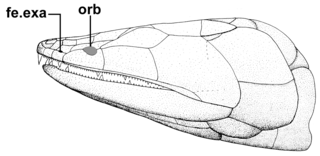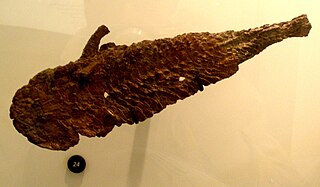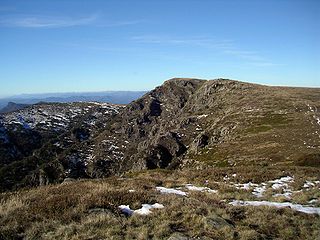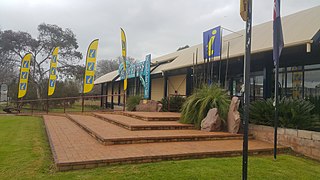Related Research Articles

James Francis "Frank" Hurley was an Australian photographer and adventurer. He participated in a number of expeditions to Antarctica and served as an official photographer with Australian forces during both world wars. He was the official photographer for the Australasian Antarctic Expedition and the Imperial Trans-Antarctic Expedition of 1914–16.

Placodermi is a class of armoured prehistoric fish, known from fossils, which lived from the Silurian to the end of the Devonian period. Their head and thorax were covered by articulated armoured plates and the rest of the body was scaled or naked, depending on the species. Placoderms were among the first jawed fish; their jaws likely evolved from the first of their gill arches.

Situated on the Belubula River, Canowindra is a historic township and largest population centre in Cabonne Shire and is located between Orange and Cowra in the central west of New South Wales, Australia. The curving main street, Gaskill Street, is partly an urban conservation area.

Bothriolepis was a widespread, abundant and diverse genus of antiarch placoderms that lived during the Middle to Late Devonian period of the Paleozoic Era. Historically, Bothriolepis resided in an array of paleo-environments spread across every paleocontinent, including near shore marine and freshwater settings. Most species of Bothriolepis were characterized as relatively small, benthic, freshwater detritivores, averaging around 30 centimetres (12 in) in length. However, the largest species, B. rex, had an estimated bodylength of 170 centimetres (67 in). Although expansive with over 60 species found worldwide, comparatively Bothriolepis is not unusually more diverse than most modern bottom dwelling species around today.

Groenlandaspis is an extinct genus of arthrodire from the Late Devonian. Fossils of the different species are found in late Devonian strata in all continents except eastern Asia. The generic name commemorates the fact that the first specimens of the type species were found in Greenland.

Mandageria fairfaxi is an extinct lobe-finned fish that lived during the Late Devonian period. It is related to the much larger Hyneria; although Mandageria was smaller, it probably hunted in the same way.

Gooloogongia is a genus of prehistoric lobe-finned fish which belonged to the group of rhizodont fishes. Gooloogongia lived during the Late Devonian period. Fossils have been found in the Canowindra site, (Australia). It was named by Zerina Johanson and Per Ahlberg in 1998. In general size and shape Gooloogongia is similar to the modern saratoga which lives in the tropical rivers of northern Australia.

Onychodus is a genus of prehistoric lobe-finned fish which lived during the Devonian period. It is one of the best known of the group of onychodontiform fishes. Scattered fossil bones of Onychodus were first discovered in 1857, in North America, and described by John Strong Newberry. Other species were found in Australia, England, Norway and Germany showing that it had a widespread range.

Materpiscis is a genus of ptyctodontid placoderm from the Late Devonian located at the Gogo Formation of Western Australia. Known from only one specimen, it is unique in having an unborn embryo present inside the mother, with remarkable preservation of a mineralised placental feeding structure. This makes Materpiscis the oldest known vertebrate to show viviparity, or giving birth to live young.
Hartley Travers Ferrar was a geologist who accompanied Captain Scott's first Antarctic expedition.

John Albert Long is an Australian paleontologist who is currently Strategic Professor in Palaeontology at Flinders University in Adelaide, South Australia. He was previously the Vice President of Research and Collections at the Natural History Museum of Los Angeles County. He is also an author of popular science books. His main area of research is on the fossil fish of the Late Devonian Gogo Formation from northern Western Australia. It has yielded many important insights into fish evolution, such as Gogonasus and Materpiscis, the later specimen being crucial to our understanding of the origins of vertebrate reproduction.

Megalichthyidae is an extinct family of tetrapodomorphs which lived from the Middle–Late Devonian to the Early Permian. They are known primarily from freshwater deposits, mostly in the Northern Hemisphere, but one genus (Cladarosymblema) is known from Australia, and the possible megalichthyid Mahalalepis is from Antarctica.

Marsdenichthys is an extinct genus of Devonian tetrapodomorph. Fossils have been found from Mount Howitt in Victoria, Australia from strata that are Givetian-Frasnian in age. Mount Howitt is an important site that has been the source of many tetrapodomorph fossils, including Beelarongia and Howittichthys, both of which were first described from the locality.
Fault Bluff is a 2,320 metres (7,600 ft) high rock bluff located about 9 nautical miles (17 km) northeast of Mount Longhurst in the Cook Mountains of Antarctica. The rock bluff was visited in the 1957–58 season by the Darwin Glacier Party of the Commonwealth Trans-Antarctic Expedition, 1956–58. They originated the name which presumably refers to a geological fault at the bluff.
Mount Ritchie is a mountain rising over 1600 m in the southeast part of Warren Range, Antarctica. The feature is 5.6 km (3 nmi) northeast of Wise Peak on the west side of Deception Glacier. Named by the Victoria University of Wellington Antarctic Expedition (VUWAE), 1970–71, after Alex Ritchie, curator of fossils at the Australian Museum, Sydney, a member of the VUWAE party that discovered important sites of fossil fish in this Skelton Neve area.

The Age of Fishes Museum is one of only two fish fossil museums in the world and is a National Heritage site due to its international scientific significance. Located in Canowindra, New South Wales, Australia, it was established in 1998. The Museum was designed by Australian architect, John Andrews. The museum houses a huge collection of Devonian fish fossils found at the Mandagery Sandstone in the Canowindra area.

The evolution of fish began about 530 million years ago during the Cambrian explosion. It was during this time that the early chordates developed the skull and the vertebral column, leading to the first craniates and vertebrates. The first fish lineages belong to the Agnatha, or jawless fish. Early examples include Haikouichthys. During the late Cambrian, eel-like jawless fish called the conodonts, and small mostly armoured fish known as ostracoderms, first appeared. Most jawless fish are now extinct; but the extant lampreys may approximate ancient pre-jawed fish. Lampreys belong to the Cyclostomata, which includes the extant hagfish, and this group may have split early on from other agnathans.

Edenopteron is a genus of large tristichopterid fish from the Late Devonian (Famennian) of what is now southeastern Australia. It is known from a single specimen of a single species, E. keithcrooki, described in 2013.
Harold Oswald Fletcher (1903–1996) was a curator and palaeontologist, associated with the Australian Museum from 1918 and retiring as deputy director in 1967. Fletcher was awarded for his contributions to Antarctic research, joining two journeys there as an assistant biologist, and wrote a personal account of the expeditions to that continent led by Mawson (1929–1931).
The Mandagery Sandstone is a Late Devonian geological formation in New South Wales, Australia. It is one of several famed Australian lagerstätten, with thousands of exceptional fish fossils found at a site near the town of Canowindra.
References
- 1 2 3 4 5 Evans, Steve (1 December 2023). "Remembering the life of Australian fossil expert Alex Ritchie". The Canberra Times. Retrieved 2 December 2023.
- 1 2 3 the, Tim (10 August 2018). "Historic Antarctica expedition footage uncovered on Canberra bookshelf". The Canberra Times. Retrieved 2 December 2023.
- ↑ "Mount Ritchie". Geographic Names Information System . United States Geological Survey, United States Department of the Interior . Retrieved 2 December 2023.
- 1 2 3 "Vale Dr Alex Ritchie". The Canowindra Phoenix. 21 November 2023. Retrieved 2 December 2023.